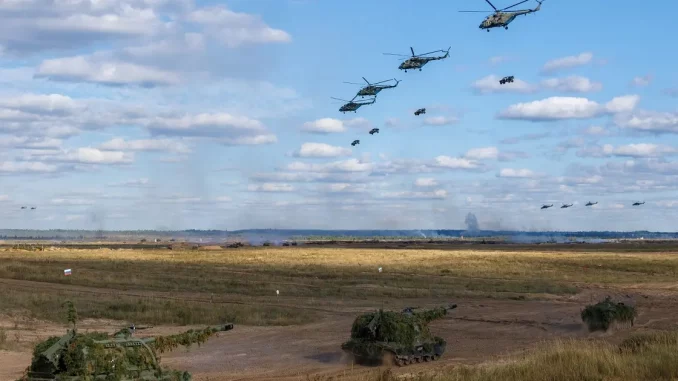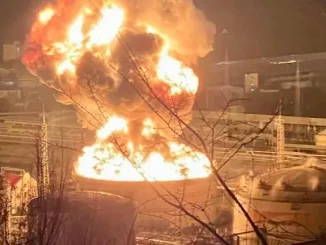
Joint Belarusian Russian military drills in 2021. (File photo: AFP)
Published September 12, 2025
Opening Curtain: Drone Crossings and an Exercise Under Scrutiny
A week that began with tension reached its apex on September 12, 2025, when Russia and Belarus commenced large‐scale joint military exercises under the “Zapad-2025” banner. The timing was charged: just two days after Poland shot down multiple Russian drones that had penetrated its airspace — the first known time in the nearly four-year war in Ukraine that a NATO country has taken such direct action.
Though Moscow and Minsk say the drills were planned well in advance, regional capitals and NATO officials view the sequencing and proximity to NATO borders as a calculated show of force.
What is Zapad-2025?
“Zapad” means “West” in Russian, and this iteration of the periodic Russia-Belarus joint exercise is significant in multiple dimensions. Here’s what is publicly known:
-
Duration & Scope: The exercises run from September 12 to about September 16 in Belarus and Russia, including drills in the Baltic and Barents seas.
-
Objectives: Moscow frames them as improving “coordination of commanders and staffs,” readiness to repel attacks, and restoring territorial integrity of the “Union State” of Russia and Belarus.
-
Troop Numbers & Location: Belarus originally announced around 13,000 troops participating. Some of the drills are held closer to NATO’s borders; others are further inland near Barysaw (about 46 miles northeast of Minsk). Smaller units will conduct operations near Poland and Lithuania.
-
Advanced Capabilities: The drills include planning for use of Russia’s Oreshnik intermediate-range missiles and practicing nuclear weapons scenarios.
Belarusian officials, notably the chief of Belarus’s General Staff, assert that much of the activity is taking place “a significant distance” from the NATO border or that the more sensitive parts have been moved inward to reduce risk.
Reactions on the Ground: Poland, Lithuania, Latvia, and NATO
The response from NATO member states near Belarus has been swift and concerned.
-
Poland has raised its alert level. It closed its border with Belarus, including railway crossings, citing national security needs.
-
Lithuania and other Baltic states have likewise stepped up border patrols and defense readiness.
-
Poland is also running its own large exercises: “Iron Defender,” involving some 30,000 troops, including 5,000 positioned directly along the Belarus border.
-
NATO officials insist that Russia’s drone incursion was a serious provocation. While Russia denies intent, Western capitals view it as a warning shot and are reinforcing their eastern flank in response.


Strategic Motives and Interpretations
Why now? Observers suggest several intertwined motivations for Moscow and Minsk:
-
Demonstration of Alliance Solidarity: The “Union State” of Belarus and Russia is being displayed as a fully integrated bloc, militarily and politically. The exercises reinforce Belarus’s role as a forward base for Russian capabilities.
-
Nuclear Signaling: With the inclusion of nuclear tools (Oreshnik missiles, nuclear planning), Russia might be seeking to raise the cost of western support for Ukraine or of NATO counter-moves.
-
Pressuring the NATO periphery: Borders with Poland, Lithuania, Latvia are vulnerable both geographically and politically. Exercises close to them exert psychological and strategic pressure.
-
Deflecting Internal and External Attention: Belarus under Lukashenko has been seeking some rapprochement with the West — for instance, by releasing political prisoners and seeking relief of certain sanctions. Meanwhile, Russia continues grappling with consequences of the war in Ukraine. Showing military readiness may serve both as a domestic legitimization tool and as a bargaining chip in diplomacy.
Risks & Potential Escalations
The situation carries several hazards:
-
Mis-calculation: Drone incursions or misunderstandings during exercises near borders risk accidental escalation. A stray projectile or misidentified movement could trigger a larger reaction.
-
NATO response: If NATO perceives these exercises as more than just posturing, it may respond with stronger counter-moves, increasing deployments, more frequent joint drills, enhanced air defenses, or even pre-positioning of forces.
-
Regional destabilization: Eastern European countries are on edge. Civil societies may feel threatened; migration, border security, energy supply, and trade could be disrupted.
-
Nuclear threshold blurring: The inclusion of nuclear capable systems in training near NATO borders increases fears that the threshold for nuclear use could be lowered, or that nuclear assets could be perceived as being on “hair-trigger” status.

 Implications
Implications
🔹 Military & Security Implications
-
Raised NATO Readiness – With exercises involving nuclear-capable missiles and tens of thousands of troops near Poland, Lithuania, and Latvia, NATO will likely boost troop deployments, air defenses, and joint drills in Eastern Europe.
-
Risk of Escalation – Drone incursions into Poland already triggered a defensive response. Any accidental missile strike, airspace violation, or misinterpretation during drills could spiral into direct confrontation.
-
Nuclear Signaling – Inclusion of nuclear planning in drills blurs the threshold between conventional and nuclear warfare, heightening fears of Moscow lowering its nuclear use standard.
🔹 Political Implications
-
Pressure on Belarus – While Minsk portrays drills as defensive, its deeper integration with Russia makes it harder for Belarus to pursue independent diplomacy or any tentative outreach to the West.
-
Unity Test for NATO – Member states near Belarus (Poland, Lithuania, Latvia) will demand stronger guarantees. How quickly and firmly NATO acts will test alliance cohesion.
-
Domestic Leverage for Putin and Lukashenko – The drills serve as a show of strength at home, projecting control and deterrence to counter perceptions of weakness due to the Ukraine war.
🔹 Economic & Regional Implications
-
Strained EU–Russia Relations – With border closures, disrupted trade routes, and higher defense spending, the economic cost for both sides will rise.
-
Migration & Border Security – Tensions could be exploited through hybrid tactics, such as pushing migrants toward EU borders (a tactic seen in past Belarus-EU standoffs).
-
Global Market Shocks – Energy and commodity markets may react to rising risk of confrontation on NATO’s eastern frontier, affecting Europe’s energy security.
 Overall Takeaway: The Message Behind Zapad-2025
Overall Takeaway: The Message Behind Zapad-2025
The “Zapad-2025” drills underscore far more than military preparedness — they are a carefully choreographed demonstration of power and intent. For Moscow, staging exercises so soon after drones strayed into NATO territory is a way to test the alliance’s resolve and signal that Russia remains unbowed despite years of war in Ukraine and mounting Western sanctions. For Belarus, the drills further cement its role as Russia’s forward operating ground, binding Lukashenko’s government more tightly to the Kremlin’s strategic orbit.
For NATO, the challenge is walking the fine line between deterrence and escalation. The alliance must assure frontline states like Poland and Lithuania that their security is ironclad, while avoiding steps that could turn posturing into open conflict. This balancing act will likely define NATO’s eastern strategy in the coming months.
The stakes are high: any misstep — whether a drone straying across the wrong border, a missile test interpreted as a threat, or a live-fire drill too close to NATO airspace — could spark a crisis far greater than intended. Beyond Europe, global markets and security partners are watching closely. Rising defense costs, border closures, and nuclear signaling ripple outward, shaping not only European stability but also wider geopolitical alignments.
Ultimately, “Zapad-2025” is not just a military exercise; it is a geopolitical performance. It signals to adversaries, reassures domestic audiences in Moscow and Minsk, and pressures NATO’s cohesion all at once. Whether it remains a show of force or becomes a flashpoint will depend on how each side interprets and reacts to the signals being sent on the borders of Europe.
SOURCES: REUTERS – Russia and Belarus start military exercise near NATO border after drone incursion
AP NEWS – Russia and Belarus launch military exercise that fueled Western concerns





Be the first to comment